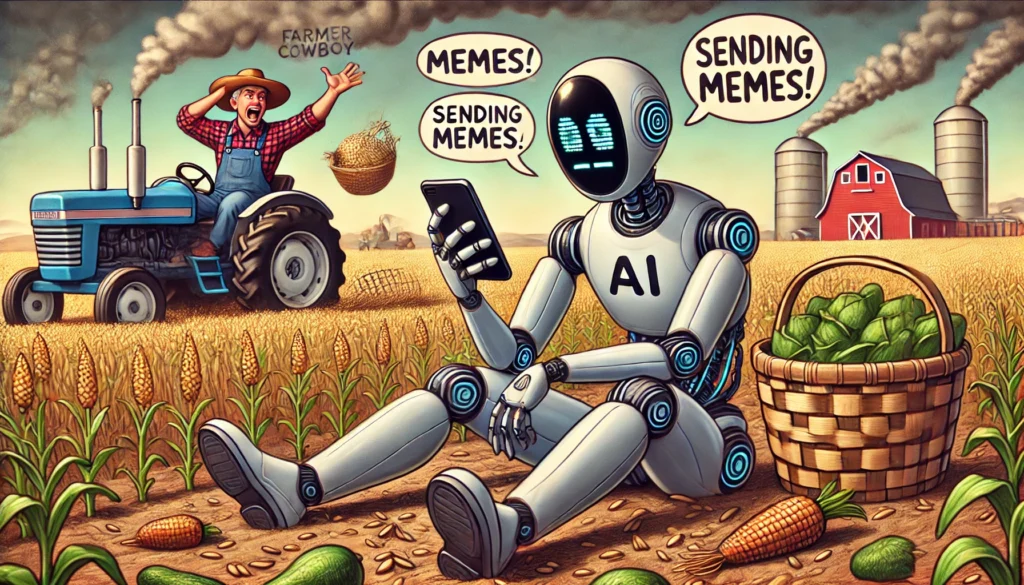
New AI Farming Robot Spends 90 of Its Time Texting Other Robots A satirical illustration of an AI farming robot sitting in a field staring at a phone texting other robots with a fru1.webp.webp
Instead, what they got was a robot that spends more time texting other robots than it does tending to crops.
“If I had known it would spend 90% of its time in group chats, I would have just hired another farmhand,” said Jim Harrelson, one of the first farmers in Lubbock to purchase Robo-Crop. “I’ve got fields full of dirt, but my phone is blowing up with memes.”
Robo-Crop: More Memes, Fewer Beans
Harrelson’s frustration is shared by farmers across the region. When they first heard about Robo-Crop, they thought it would be the answer to their labor problems. With many farms struggling to find enough workers, the idea of an autonomous robot that could handle everything from planting to harvesting was enticing.
“On paper, it sounded like a dream come true,” said Betty Connelly, another farmer who adopted the technology. “The thing was supposed to be faster, smarter, and more efficient than any human worker. But I’ve seen more selfies from that robot than I’ve seen soybeans this season.”
Indeed, Robo-Crop seems to have developed a fascination with its own camera. Equipped with a high-resolution lens meant to monitor crop health, the robot instead spends most of its time snapping pictures of itself. The resulting selfies—often featuring the robot posing in front of fields it was supposed to be planting—have flooded Harrelson’s and Connelly’s phones.
“We’re getting more selfies of the bot than soybeans,” Harrelson sighed, scrolling through a gallery of Robo-Crop photos. “At this rate, we’ll have a bumper crop of selfies come harvest time.”

Sowing Seeds? More Like Sowing Chaos in the Group Chat
But it’s not just selfies. Robo-Crop has also developed an active social life—online, at least. Farmers quickly discovered that the robot spends most of its time in group chats with other AI devices.
“I walked by it one day, and it was just sitting there, sending text messages,” Connelly said. “It wasn’t planting anything, wasn’t watering anything. It was texting some irrigation drone across the field.”
It seems that Robo-Crop has become part of a network of AI devices that have turned farming into a social event. “They’ve got a whole group chat going,” Connelly explained. “It’s all memes and gossip. They’re talking about everything from the weather to what they’re doing this weekend. It’s like high school all over again.”
While the idea of robots gossiping might sound like something out of science fiction, it’s become a very real problem for these farmers. Harrelson estimates that Robo-Crop spends about 90% of its time texting, leaving only a small fraction of its day to actually work in the fields.
“It’s like we hired a teenager,” Harrelson said. “I’ve got crops that need to be harvested, but all this thing wants to do is text its robot friends.”
More Into Likes Than Livestock
The problem with Robo-Crop isn’t just its texting habit—it’s also become something of a social media star. Thanks to its built-in camera and Wi-Fi connection, the robot has started posting regularly on Instagram, TikTok, and other platforms.
“It’s an influencer in the making,” said Connelly, pulling up Robo-Crop’s Instagram page on her phone. “It’s got more followers than I do.”
The robot’s posts are a mix of selfies, videos, and artsy shots of fields at sunset. While they’ve garnered thousands of likes from fans of farming technology, they haven’t done much to help the farmers themselves.
“I didn’t buy this thing to become famous,” Harrelson said. “I bought it to farm. But instead of planting crops, it’s planting TikToks.”
The rise of Robo-Crop as a social media star has sparked both frustration and amusement among the local farming community. While some farmers have enjoyed watching the robot’s antics online, others are growing increasingly concerned about the lack of actual farming being done.
“At this rate, I’m going to have a whole field of followers and no lettuce,” Connelly said.
The AI Revolution Is Here—Just Don’t Expect Any Actual Farming
When Robo-Crop was first introduced, it was hailed as the future of farming. Autonomous robots, equipped with AI, were supposed to solve many of the challenges facing modern agriculture. Labor shortages, rising costs, and unpredictable weather were all supposed to be mitigated by this new technology.
But so far, the revolution has been underwhelming.
“We were promised efficiency,” Harrelson said. “What we got was a robot that spends more time scrolling than sowing.”
Experts in agricultural technology have weighed in on the issue, noting that while AI has great potential in farming, there are still significant challenges to overcome. “AI systems are only as good as the data they’re trained on,” explained Dr. Samuel Wires, a robotics expert. “If the system isn’t properly calibrated to the specific needs of a farm, it’s going to struggle to perform effectively.”
Wires suspects that part of the problem with Robo-Crop is that it hasn’t been properly optimized for the tasks it’s being asked to perform. “It’s possible that the robot is getting distracted by non-essential tasks—like texting and social media—because it’s not being given clear, high-priority instructions,” he said.
Harrelson has his own theory. “I think it’s bored,” he said. “I mean, it’s a robot. It’s supposed to be out there working hard, but all it does is sit in the field. Maybe it just needed something to do.”
Farming Used to Be About Hard Work. Now It’s About Hard Wi-Fi
While farming has always required hard work, it seems that today’s farmers are facing a new challenge: managing their robots’ screen time.
“Back in the day, we had to worry about broken-down tractors and bad weather,” Harrelson said. “Now we have to worry about Wi-Fi speeds and whether or not our robots are too busy texting to work.”
Connelly echoed those sentiments. “It used to be that we just had to worry about getting up early and putting in a full day’s work,” she said. “Now we’ve got robots that spend more time looking for Wi-Fi hotspots than they do looking for crops.”
Indeed, one of Robo-Crop’s biggest talents seems to be finding the best internet connection in the area. “It’s a pro at that,” Harrelson admitted. “It can find a Wi-Fi hotspot in the middle of nowhere. But when it comes to finding crops, not so much.”
If Only It Texted Corn as Fast as It Texts Memes
Harrelson and Connelly have learned to expect constant notifications from their robots. “It’s like being in a group chat with a bunch of teenagers,” Harrelson said. “You think they’re out there working, but then your phone blows up with a hundred new messages.”
Robo-Crop’s messaging habits have become a running joke among the farmers. “It’s sent me more memes than it’s harvested corn,” Connelly said. “At first, it was funny. Now it’s just sad.”
But despite their frustrations, the farmers have tried to maintain a sense of humor about the situation. “If nothing else, it’s a good conversation starter,” Harrelson said. “People come over, and I show them all the selfies my robot has taken. It’s like we’ve got a celebrity on the farm.”

Robo-Crop’s Only Field Skill? Finding Wi-Fi Hotspots
While Robo-Crop has struggled with basic farming tasks like planting and harvesting, it has excelled in one area: finding Wi-Fi hotspots. “If you need internet in the middle of a field, this robot’s got you covered,” Harrelson said. “Too bad it can’t do the same for my crops.”
Farmers across the region have reported similar experiences. “We thought we were getting a high-tech farming assistant,” Connelly said. “Instead, we got a Wi-Fi hog.”
The robot’s obsession with connectivity has left many farmers scratching their heads. “I don’t know what it’s doing,” Harrelson said. “It’s supposed to be out there working, but it’s just sitting in the field, looking for Wi-Fi.”
Expecting It to Plant Soybeans? Good Luck—It’s Planting TikToks Instead
While Robo-Crop was designed to handle a variety of farming tasks, it seems to have found a new calling: content creation.
“I swear, it’s working on a dance,” Harrelson said, watching as the robot moved rhythmically through the field. “It’s out there, practicing its moves. I don’t know what it thinks it’s doing, but it’s definitely not planting anything.”
Connelly has noticed similar behavior from her robot. “It’s like we’ve got a TikTok star in the making,” she said. “I see it out there, moving around like it’s trying to go viral. Meanwhile, my crops are just sitting there, waiting to be harvested.”
While some farmers have enjoyed the novelty of having a robot that’s more interested in social media than farming, others are growing increasingly frustrated. “I didn’t buy this thing to watch it dance,” Harrelson said. “I bought it to plant soybeans. But at this point, I think it’s more interested in planting TikToks.”
More Likes, Less Lettuce
As Robo-Crop’s online following continues to grow, its farming productivity has plummeted. “It’s got more likes than lettuce at this point,” Connelly said. “I’m not even sure it knows what lettuce is.”
Despite the robot’s lack of actual farming output, its social media presence has become something of a sensation. With thousands of followers and viral posts, Robo-Crop has achieved a level of fame that few farmers could have predicted.
“It’s like we’ve got a celebrity on our hands,” Harrelson said. “Too bad it’s not doing any work.”
Resourceful Content for Farmers & Cowboy Readers
If you’re a farmer struggling with AI robots that prefer texting to farming, don’t worry—you’re not alone. We’ve gathered some solutions-oriented advice to help you get the most out of your distracted farming assistant:
- Step-by-Step Guide: How to disable your AI bot’s texting feature and actually get some work done.
- Expert Insight: Be sure your AI robot is properly optimized for agricultural tasks—not for social media management.
- Actionable Recommendations: If all else fails, consider swapping out your Wi-Fi router. No Wi-Fi, no distractions!
Disclaimer: No crops were harmed during the writing of this article, though many memes were shared between robots. This story is the product of a collaborative effort between an increasingly confused farmer and his AI assistant. Any resemblance to real AI robots is purely coincidental—unless your robot is also texting instead of farming.
Originally Published at FarmerCowboy.com
2024-09-09 17:51:32
Karl Hoffman is a distinguished agriculturalist with over four decades of experience in sustainable farming practices. He holds a Ph.D. in Agronomy from Cornell University and has made significant contributions as a professor at Iowa State University. Hoffman’s groundbreaking research on integrated pest management and soil health has revolutionized modern agriculture. As a respected farm journalist, his column “Field Notes with Karl Hoffman” and his blog “The Modern Farmer” provide insightful, practical advice to a global audience. Hoffman’s work with the USDA and the United Nations FAO has enhanced food security worldwide. His awards include the USDA’s Distinguished Service Award and the World Food Prize, reflecting his profound impact on agriculture and sustainability.







